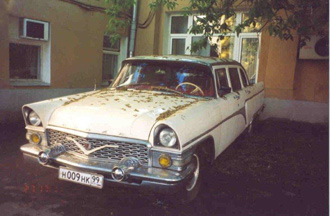Lewis H. Siegelbaum
Cars for Comrades: The Life of the Soviet Automobile
Cornell University Press
309 pages, 9 x 6 inches
ISBN 978 0801446382
I set out to write a book not so much about the varieties and comparative deficiencies of cars in the Soviet Union as what these objects meant to Soviet citizens. The structure and organizing principles of the book were among the first things to become clear. There would be three chapters on the “Soviet Detroits” – the places where automobiles were built, the people who built them, and how the cars and trucks they produced both embodied the state's agendas and inspired popular identification.
I settled on Moscow's AMO factory (later known as ZIS and still later ZIL) from where the first Soviet-made motor vehicles emanated in 1924; the Gor'kii Automobile Factory (GAZ) that began turning out Model A cars and trucks in the 1930s and later the Pobeda, Volga, and Chaika; and AvtoVAZ, the giant factory built on the banks of the Volga in the late 1960s and early 1970s to produce the Zhiguli, or as it became known abroad, the Lada.
These chapters would be followed by one on roads and their construction, the forms of labor relied upon to build and maintain them, and other dimensions of the struggle against “roadlessness.” The final two chapters would tell the story of how Soviet citizens experienced trucks and cars in their daily lives, how Communist ideology eventually accommodated the private automobile, but why cars required a lot of semi-legal or illegal activity to keep them on the road.
The book is structured around three axes: foreign and domestic, public and private, and continuity and change.
Contrary to Cold War-era assertions, the Soviet automobile industry was neither entirely dependent on nor completely autonomous from western technological developments. It did a lot of copying, mixing and matching, and innovating on the fly. In the 1930s, Soviet highway design and construction emulated Fascist Italy’s autostradas and Nazi Germany’s autobahns but for better or for worse otherwise depended on indigenous inspiration and approaches. Foreign trucks and cars – the pre-revolutionary playthings of the aristocracy, the “Renochka” that the revolutionary poet Vladimir Maiakovskii bought as a gift for his mistress, the legendary Lend Lease Studebakers, the trophy cars that Red Army officers brought back from defeated Germany, Detroit's finest on display at the 1959 American National Exhibition in Moscow – were icons of a world few Soviet citizens had seen. Yet, Soviet citizens took pride in “their own” luxury models (ZIS and ZIL limousines, Chaikas, etc.), thrilled to accounts of auto races and rallies in which Soviet drivers heroically overcame obstacles, and for the most part leapt at the opportunity to acquire even the most modest of Soviet models.
Actually, even the state’s property – trucks and, until the 1970s, the vast majority of cars – often was appropriated for private or personal purposes by drivers and officials in need of wheels. With the proliferation of privately owned cars in the 1970s and 80s, owners appropriated state supplies of parts and gasoline too. The mutuality of such relationships and the hybridity of forms they produced meant that occasional ruptures in the life of the Soviet automobile did not prevent the emergence over the long haul of a Soviet “automobility.” Many of its features survived the collapse of the USSR itself.
The book’s main argument is that the Soviet automobile had to adapt to Soviet circumstances as much as it provoked adaptation. If the particularities of Soviet socialism can better inform us about the history of cars and trucks, then the Soviet automobile can help teach us about Soviet socialism.

Contrary to Cold War-era assertions, the Soviet automobile industry was neither entirely dependent on nor completely autonomous from western technological developments.
No contextual landscape for the book existed in the sense of a previous body of historical scholarship devoted to the subject. The Soviet automobile did figure in Cold War-era economists’ reckonings of the so-called “second economy.” And sociologists, anthropologists and historians have been producing an impressive number of articles and books on car and truck cultures in many parts of the world (although not the USSR or other former Soviet-bloc countries). But the twin inspirations for the writing the book came from elsewhere.
Visiting Moscow and other ex-Soviet cities during the 1990s, I could not help noticing the tremendous increase in the number of cars and the difficulties urban infrastructures had in accommodating their growth. This observation made me reflect on the intricate relationships among cars, cities, political systems and the choices they offered and constrained with respect to human mobility. It also made me start to notice the presence of cars and trucks in a lot of places previously hidden in full view – in Soviet novels, poetry, films, photographs, and songs, in the speeches by Soviet leaders, in memoirs and elsewhere. Soon my project was awash with material.
The other source of inspiration was my own weariness with the narrative of Soviet history that emphasized tears, state oppression, and violence – a narrative especially prominent in and appropriate to accounts of the Stalin era. This was the period in which most of my previous scholarship was situated. I longed for a subject that was more capacious, that would enable me to trace its arc through the entirety of the Soviet Union’s existence, and found it in the odd coupling of the automobile and Soviet communism.
Of course I encountered tears and shed a few of my own as I struggled to master the vocabulary of auto mechanics. But among the unexpected pleasures of writing this book were several discoveries among the myriad of sources: film comedies from the Soviet 1950s and 60s about a driver and his boss in a case of mistaken identity, about a would-be ice skating princess who settles for becoming the best gas station attendant by filling up the tanks on roller skates; a Stalin-prize winning novel from 1950 in which a truck driver rhapsodizes about the joy of the open road; and Ilya Ehrenburg’s 1929 dystopic novel about the devastating effects of the automobile on labor, the environment, and pedestrians. From the latter, I derived the subtitle for my book.
A Chaika in the courtyard of a Moscow apartment building, May 2006. Photo Lewis Siegelbaum.

The spatial requirements and landscape consequences of the automobile age – the roads, oil and gas refineries and stations, garages, tire and parts stores and junk yards, billboards and flashing neon signs, suburban tracts and shopping malls – hardly made their presence felt in the USSR. “Consequently,” wrote a Dutch-born writer in the late 1960s “the Westerner in his own car …moves in an odd way back through time” to “how [our world] once looked, how it was supposed to look.”
Still, already in 1960, Krokodil, the Soviet humor magazine, could print a cartoon of makeshift sheds disfiguring the courtyard of a new apartment bloc, and residents in Leningrad soon were lodging complaints about garages getting “in the way of people’s everyday lives.” The proliferation of private automobiles also had temporal consequences as car owners required considerable amounts of time to maintain and repair their vehicles.
Hence, car owners and car parts suppliers both of whom were overwhelmingly male appropriated courtyards, alleys, roadsides and fields for the predominantly masculine activities of car work and car talk. Garages, furnished with old chairs and perhaps a heater and a cot became sites of celebration – places to drink vodka and consume sausage and pickles. They and the interiors of the cars themselves served as alternative living rooms for men seeking privacy and male companionship. The essentially private activities in which they engaged thanks to the car and the infrastructural inadequacies of the centrally planned economy were beyond the surveillance not only of their wives but of the state that inadvertently had fostered them.
All of this was a long way from the vision of Valerian Osinskii, a prominent Bolshevik who did more to give life to the Soviet automobile than anyone else. In a series of articles that Pravda published in 1927, Osinskii called upon his comrades to adopt the “American automobile” instead of the “Russian cart” and thereby put “every worker and peasant in a car within not more than ten to fifteen years.” Osinskii also dreamed of a future in which a car trip from Moscow to the provincial town of Voronezh would mean traveling on an asphalt highway so smooth that the only sound heard would be the swish of tires. Only since the collapse of the USSR have such journeys become possible, but at the same time, the post-Soviet landscape is now littered with the detritus of the automobile age.

Soviet socialism exchanged the possibility of an alternative modernity for one much more entangled with the material culture of the western world.
In the late 1950s, Nikita Khrushchev, who never had been a fan of the private car, proposed a rental system as an alternative route to automotive modernity. “We will use cars more rationally than the Americans,” he assured an audience in Vladivostok. But even before his ouster in 1964, the system that had lacked funding and provoked innumerable complaints was phased out. With it went the chance for the USSR to take advantage of its relatively late entry into the automobile age and improve on the record of its predecessors.
Cars for Comrades is about more than cars. It is about the chimera of overcoming the gap in technology between the capitalist (First) and socialist (Second) world. Even as Soviet and American engineers were installing an assembly line to turn out Model A trucks and cars in the late 1920s, Soviet journalists were conjuring up visions of a technological utopia, not just a factory out of which would rumble identical machines one after the other, but an entire city, the “City of Socialism” lit by electricity, heated by steam, and with rectangles everywhere. But the capitalist world’s technology was a moving target. By the time the techno-utopian “Soviet Detroit” of the future was actually built – in the early 1970s in Togliatti to complement the AvtoVAZ factory – the real Detroit was definitely showing signs of stress and decay from which it would not recover.
The book’s larger significance is about the intersection of technology, ideology, and material culture. I argue that Soviet socialism exchanged the possibility of an alternative modernity for one much more entangled with the material culture of the western world.
This process was difficult to predict. For much of its existence, the Soviet Union was defined by its leaders as a more rationally organized and socially just polity than any in the capitalist world. The preponderance of trucks – those workhorses among motor vehicles – and the rare privately owned car was consistent with such difference. But eventually the comrades and other middle-echelon personnel wanted to enhance their personal mobility, flexibility, and status. They wanted the wealth within what had become a vast empire to be shared with them not only in the form of access to first-rate educational institutions, vacations abroad, family apartments, and domestic appliances but that most representative of twentieth-century material objects – the car.
In the end, they got their way, sort of.




We don't put paywalls. We don't distract you with ads. We don't sell your data.
Please help to keep this running!